Newfoundland and Labrador
All photos and words by Myriah Saulnier
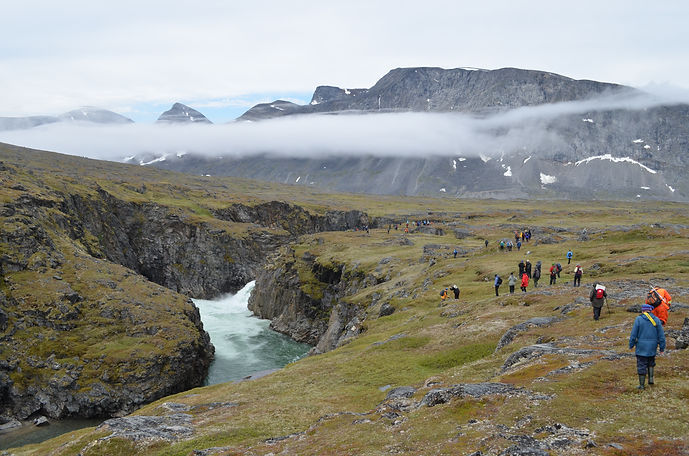
**Please read the printed copy of Canadian Traveller magazine's Fall 2015 issue, where this article is cleverly laid out, with helpful sidebar information for travellers and extra photos.**
Newbies and professional adventurers alike can now explore Canada’s East Coast by water, allowing them to hike through the Torngat Mountains, observe polar bears, gawk at old shipwrecks, stand at the easternmost point in Canada, and travel via zodiac to giant waterfalls and icebergs. This expedition, offered by Adventure Canada, leads travellers to wonders seemingly out of this world and hardly visited, while still including quiet moments to discover local culture.
Hiking through the isolated Torngat Mountains National Park, with our bear scout near and our rubber boots - worn for our wet landing from the zodiacs - squeaking with every step. Even though I wasn't wearing the most comfortable or lightweight equipment and clothing, I felt as if I was light as a bird in this magical place: its name translated means "place of spirits".
I just hiked a mountain in polar bear country, my equipment tugging my shoulders from my backpack and my green rubber boots squeaking with each step on the marshy ground. As uncomfortable as that sounds, I still felt as if I was floating in clouds. I was beside a massive waterfall – its rushing water tumbling between a maze-like assembly of grayish, red toothed rock - and towering black mountains behind, its peaks snow-covered. “Is this real?” the words flew out in a whisper. This sensation lingered throughout the three day exploration of the Torngat Mountains as I saw seemingly impossible sights. Back on ship, Adventure Canada passengers shared a unique high only the Torngats could provide.
This was the end of our trip of wonders. They had saved best for last, our excitement from the previous landings bubbling to the surface for the grand finale. Of course we had to begin the trip somewhere equally as lovable. Of all places on Newfoundland and Labrador’s gorgeous, historical and adventurous coast, we took off from the city known by cruise lovers as “the place where residents wave and boats in the harbour perform an orchestrated musical number for your embarkment.” Yes, we were leaving from dreamy St. John’s, Newfoundland.
ST. JOHN'S, NEWFOUNDLAND
Do strangers still say good morning when passing on the street and bring soup to their sick neighbours? They do here! Experiencing historical fishing villages, such as Quidi Vidi, is like stepping back in time. Houses are colourful and old-fashioned, streets are made for one car and everyone knows each other by name.
With such a small-town feel, I was impressed with St. John’s expanding food scene that has a strong focus on local produce. Classy, award-winning restaurant Bacalao was a favourite. They use local ingredients to create savoury masterpieces. Their most popular dishes include battered, salty cod tongues and sweet homemade ginger cake. Other innovative restaurants include quaint and romantic Oliver’s Restaurant and pricey but sophisticated Raymonds Restaurant.
Twenty minutes from downtown is Cape Spear Lighthouse National Historic Site of Canada. The restored lighthouse gives insight to what life was like for a 19th century lighthouse keeper’s family. The short hike by the headlands brings travellers to the easternmost point in Canada as well as to the ruins of a Second World War coastal defense battery, Fort Cape Spear.
Another landmark worth visiting is Signal Hill, with its panoramic view of St. John’s picturesque harbour and bulky mountains diving into the Atlantic. The famous George Street is always lively with several pubs and its rich music scene. You might bump into Great Big Sea’s lead singer Alan Doyle, since he often visits O’Reilly’s when in town.
ROSE BLANCHE, NEWFOUNDLAND
The 400 resident community Rose Blanche was
charming. Their church opens its doors to cruise ship
visitors and welcomes them with live Newfie music,
smiling church ladies and tables of fresh baked
pastries.
The view of the blue bay with houses lined at its peaks
was pretty, but the real views awaited those who
followed the 2.5 kilometer trail from the docks to
Rose Blanche Lighthouse. Once through the terrain
of strenuous hills, slippery grass and tiny cracks, I
immediately felt it was worth it. I reached the
lighthouse on the hill, surrounded by panoramic views
so gorgeous I sat down where I was. It was the perfect
picnic spot before the granite lighthouse, overlooking
whales in the sea and waves crashing into the
rocky white cliffs.
GROS MORNE NATIONAL PARK, NEWFOUNDLAND
Every geologist’s dream, Gros Morne National Park provides some of the best illustrations of plate tectonics in the world. Shaped by colliding continents and glaciers, the oceanic crust and mantle rocks of this ancient landscape describe ages of geologic chaos and reformation. The fascinating features of the park also include natural fjords between red desert mountains and green forest mountains.
Tours are available by Parks Canada to the top of Gros Morne Mountain, to explore the orange rocks of the uninhabited tablelands, to discover sea caves and to walk the volcanic rock coast on the Green Gardens trail.
Woody Point, the town in the heart of Gros Morne, has less than 10 boutiques on the main street, each offering something different. The most captivating was Galliott Studios, a cute arts shop and café which also sells wine and beer. Through the shop and out back is a bright red patio directly on Bonne Bay, perfect for sipping and gazing at mountains. Uniquely, the shop was converted from a 100-year-old fishing shack owned by the owner’s grandfather. The studio features regular book readings and live music, and is an important hub for The Writers at Woody Point literary festival that sells out every year.
RED BAY, LABRADOR
Red Bay was once home to a 16th century Basque
whaling station (now Canada’s newest UNESCO World
Heritage Site), which was established by Basque whalers
from Spain and France who made seasonal trips to
Newfoundland’s coast to hunt whales for blubber.
The blubber, once rendered into oil, would light
European lamps for decades.
The remnants of oil-rendering ovens and the location of
the Basque whaling station is on Saddle Island, at the
mouth of the bay. Don’t miss the grounded shipwreck
believed to be the Bernier, one of the Spanish Basque
galleons found in Red Bay. It’s captivating.
ST. ANTHONY & L'ANSE AUX MEADOWS, LABRADOR
St. Anthony provided two distinct highlights. The first
being the elegant, 1967 ceramic Jordi Bonet Murals in
the Memorial Hospital. The jewel shades of crimson,
aqua and blue-green blended with realistic and abstract
images of native life will inspire you to wonder the
symbolism behind it all.
The second highlight was L’Anse aux Meadows National
Historic Site, the only authenticated Viking site in North
America. You can stand in the preserved remains of three
halls and five smaller buildings made by the Vikings.
Reconstructed huts accompanied by Viking re-enactors
welcome you at the end of the boardwalk trail, as well as
close by at Norstead, A Viking Village and Port of Trade.
Both sites allow you to handle reproduction artifacts and
experience the Norse lifestyle of 1,000 years ago.
HEBRON, LABRADOR
The controversial move the government made forcing the relocation of the Inuit who resided in Hebron in 1959, gives this lost land a sobering tone.
Seven original buildings of the Moravian Mission Station, once inhabited here, still stand in reasonable condition considering the harsh climate and time passed. The main mission building has been renovated by Inuit volunteers and can be explored.
Two monuments stand at Hebron: one is an inscribed apology for the site closure by the provincial government, the other is a reply from the Nunatsiavut government. Both are worth reading.
TORNGAT MOUNTAINS NATIONAL PARK, LABRADOR
Each landing spoiled me with adventure. But
when I took my first steps in the Torngat
Mountains National Park, it was different.
Any stress I might have had washed away as
my wild eyes took in the line of crisp fog
hovering over the waterfall more magnificent
than any skyscraper, with enormous mountains
on each side, all shades of grey, red or black.
I was an ant in this giant world untouched by
civilization. The silence hung in the air, broken
only by the waterfall and birds. I hiked as far as
the bear guide would allow into the mountain
valleys, up the sides of waterfalls and rocky
cliffs, because I had been ignited. This was the
most enchanting place I had ever experienced
and I wasn’t going to miss a thing.
I left the Torngats and finished my expedition through Newfoundland and Labrador bursting with experiences and stories I will remember for life, like snapshots seared into memory of the biggest adventure I ever had.
Only one thought seemed to trouble me: How will anyone believe little, nervous, sluggish me conquered a mountain in polar bear country?
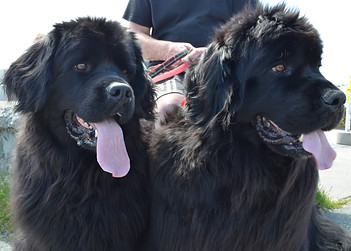
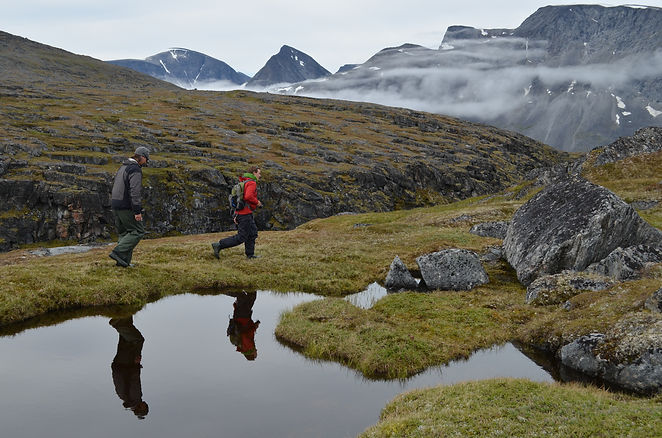



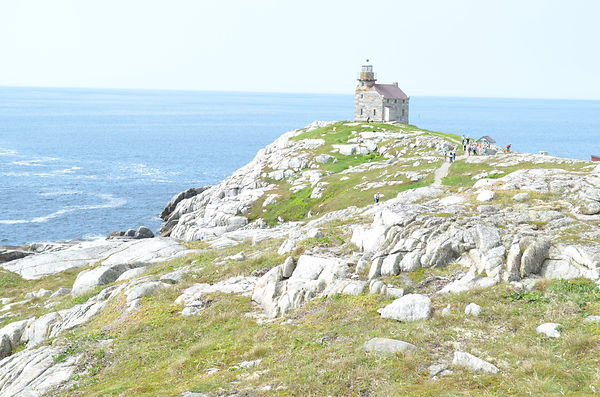






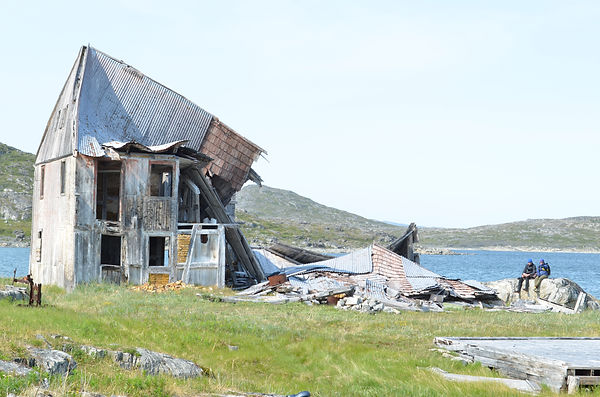
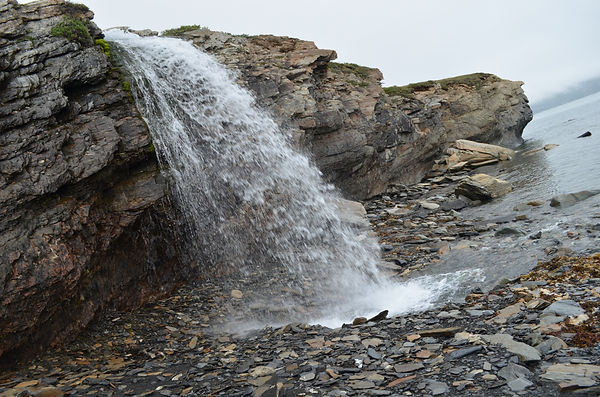
LEFT: The beautiful historic fishing village of Quidi Vidi, pronounced 'Kiddy Viddy'.
BELOW: Newfoundlands, the famous breed of dogs who have webbed feet and a water resistant coat. Originally working dogs for Newfoundland fishermen.
LEFT: Rose Blance's lighthouse against the baby blue backdrop of the ocean makes for the perfect picnic spot, with whale watching in the distance.
BELOW: The view of the 'white rock' Newfie town from my favourite part of the 2.5 km walk to the famed lighthouse.
TOP LEFT FIRST: On one of Gros Morne National Park's many trails, all of which highlight its wide variety of flora and fauna and rocks.
TOP LEFT SECOND: The quaint and colourful main street of Woody Point.
ABOVE: Fog surrounds this shipwreck believed to be the Bernier, one of the Spanish Basque galleons found in Red Bay. She is grounded close to Saddle Island.
LEFT: Overlooking St. Anthony from Tea House Hill, found at the end of a walking trail which also holds the burial site for the town's famous doctor, Dr. Grenfell.
ABOVE: One of the many reconstructed sod huts, part of L'Anse aux Meadows National Historic Site which is the only authenticated Viking site in North America.
BELOW: A section of the wonderous, brilliant coloured Jordi Bonet Murals, located in the Charles S. Curtis Memorial Hospital.
ABOVE: Deepthie Rajapakse plays a tune on her flute for the Inuit people that once inhabited the controversial site of Hebron and who were forced to leave.
LEFT: This abadoned building, half of it still managing to stand despite the tests of the oceanic climate, is one of about five buildings left depicting the settlement of Hebron.
LEFT: Two men, passengers from the Adventure Canada expedition, run through the Torngat Mountains for their first time.
BELOW: When hiking into the Torngat mountains with our bear guards close and our cameras closer, it was hard to keep moving when all we wanted to do was gawk at the beauty of every single angle this magical land provided.